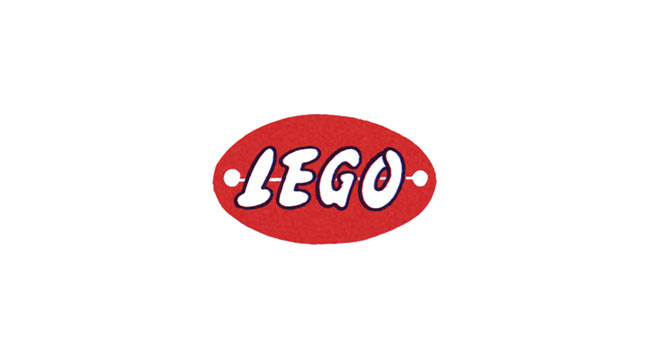The story began in 1932, when carpenter and joiner Ole Kirk Kristiansen established his business in the village of Billund, Denmark, manufacturing stepladders, ironing boards, stools, and wooden toys. His son Godtfred Kirk Christiansen started working in the business alongside him, aged just 12.


In 1934, Ole’s company and its products adopted the name LEGO, an abbreviation of the two Danish words “leg godt,” meaning “play well.” The first company logo was used on correspondence, shipping labels, and other printed materials, but not yet on toys.


This ink stamp “LEGO Fabriken Billund” was first used on wooden toys in 1936.



The factory had 10 employees by the time this logo iteration was introduced in 1939 or 1940. For the next 10 years it was used extensively on wooden toys, typically in the form of an applied decal.
In 1949, the forerunner to the LEGO brick we know today was launched under the name Automatic Binding Bricks.

In 1951, the Binding Bricks name was supplanted by LEGO Mursten (literally LEGO Bricks) because Ole’s son, Godtfred, wanted to establish wider recognition of the LEGO name.






During 1953, all three of the above logos were used.



The first of the oval logos, this appeared on LEGO Mursten catalogues. The company still hadn’t standardised the brand colour, and examples exist in several variations, typically depending on the colour of the catalogue.

This logo first appeared on the System i Leg (System of Play) sets. The original appears to be hand-drawn and differs on various boxes from early 1955.

The classic dog bone logo from late 1955 was the first time the logo was standardised in design and colour. It was used across all toys lines and appears widely on both plastic and wooden toys.

The current LEGO brick stud-and-tube coupling system was patented in 1958, the same year Ole Kirk Kristiansen passed away and his son Godtfred became head of the company. There were 140 employees in Billund.

The first of the rectangular/square logos. This and many variants were used worldwide for the next 13 years.




A variation of the 1960 logo that includes the yellow, red, blue, white, and black bars, and was the first to show the registered trademark symbol alongside the LEGO name.



This logo appeared in 1973, the same year that LEGO began production and distribution in the US. It represents an attempt to cement a single worldwide logo and remains the most recognisable version of LEGO’s brand identity.



A subtle refinement (a “graphic tightening” in LEGO’s words) of the 1973 logo for better digital (i.e. internet) reproduction.

In 2000, LEGO was named “Toy of the Century” by both Fortune magazine and the British Association of Toy Retailers, and today the LEGO Group is owned by grandson of the founder, Kjeld Kirk Kristiansen, the richest person in Denmark.

Sources:
Explore the LEGO history, on LEGO.com.
Brickipedia, the free LEGO encyclopaedia.





Comments
LEGO will always bring a smile to my face. Thank you for sharing another part of this awesome company history.
Hello, what a lovely story! Thanks for sharing. Can you let me know where can I find the LEGO logo sign taken in Putrajaya Malaysia? It would be great to check it out next time I am there!
Hello, I’m pretty sure it’s at the LEGO store in the IOI City Mall.
Wow, that was really interesting!
Para los que queráis leer la historia de Lego en castellano o escucharla en formato podcast os dejo este enlace.
Used to do a lot of work for Lego at one time, this is fascinating to see, thanks!
A pleasure, folks. Thanks for reading.
Spectacular review on the development of the Lego logo. Greetings from Costa Rica.
It was a pleasure to surf through the history of the logo. Thanks a lot!
Seeing the 1984 castle was like the golden years of my life flashing right before my eyes! Lego is easily the best toy ever.
Let’s say the current logo is almost the same as it was in 1973. If we agree with that, LEGO’s logo is one of the oldest without major changes, wow :)
I used this info for my school project, thanks!
Happy to help, Eli. All the best with your studies.
I used this for my project, too, thanks for the information! :D
Really interesting to see how the logo has evolved over the years. Can see some of the familiar style coming in at 1960-1965.
I’m looking for the classic space Lego picture with the spaceship flying around a planet… Would love a t-shirt with that print!
You don’t have to look too far!
https://www.teepublic.com/t-shirt/230996-classic-space
I loved how all the LEGO logos stayed with a somewhat similar design.
Thank You. My first lesson for it in the LEGO logo branding concept.